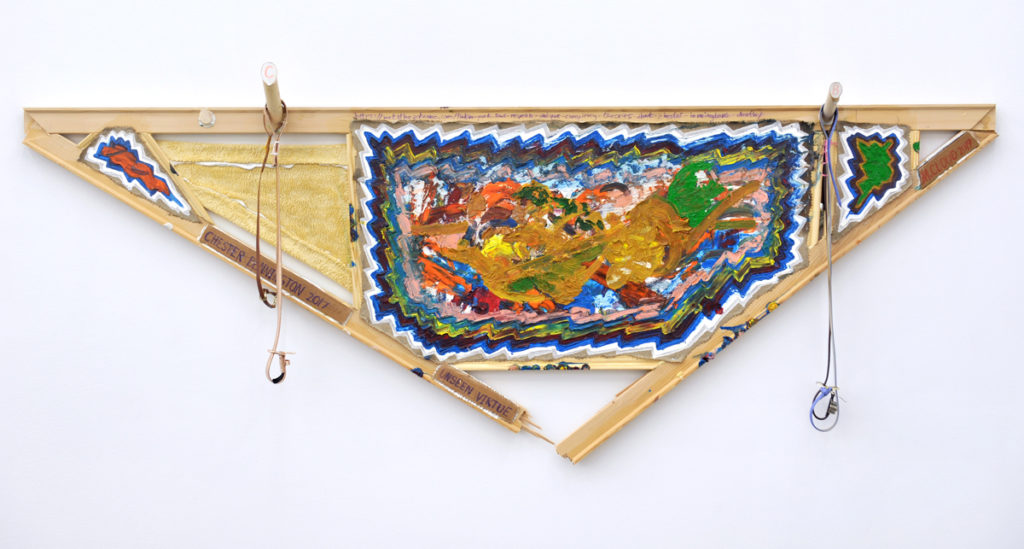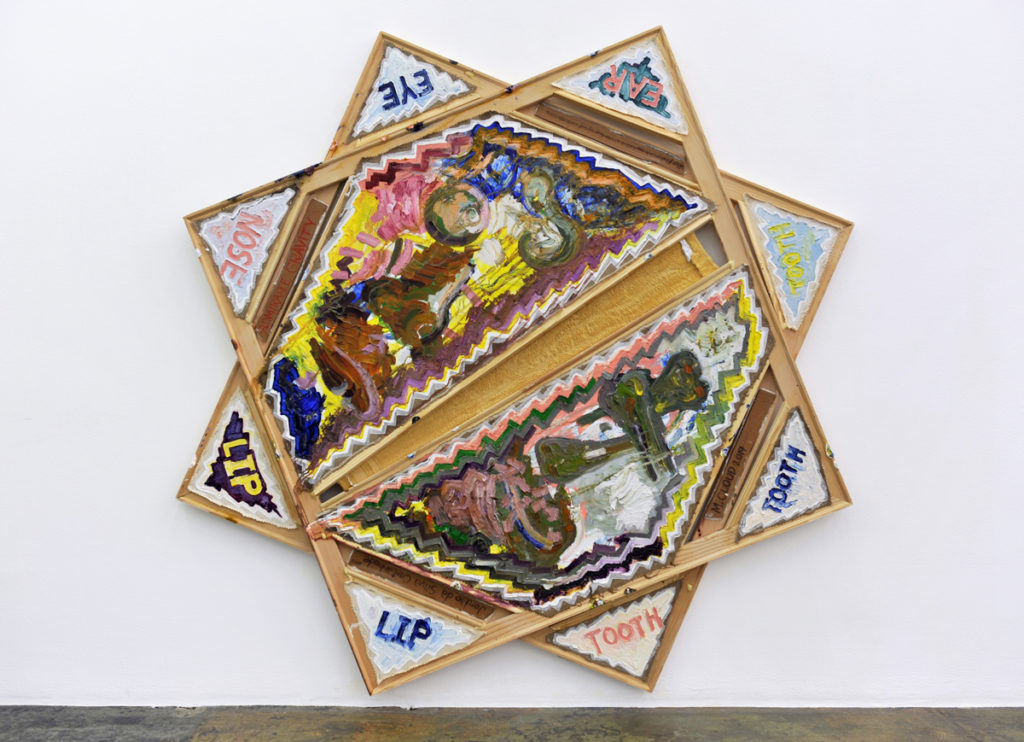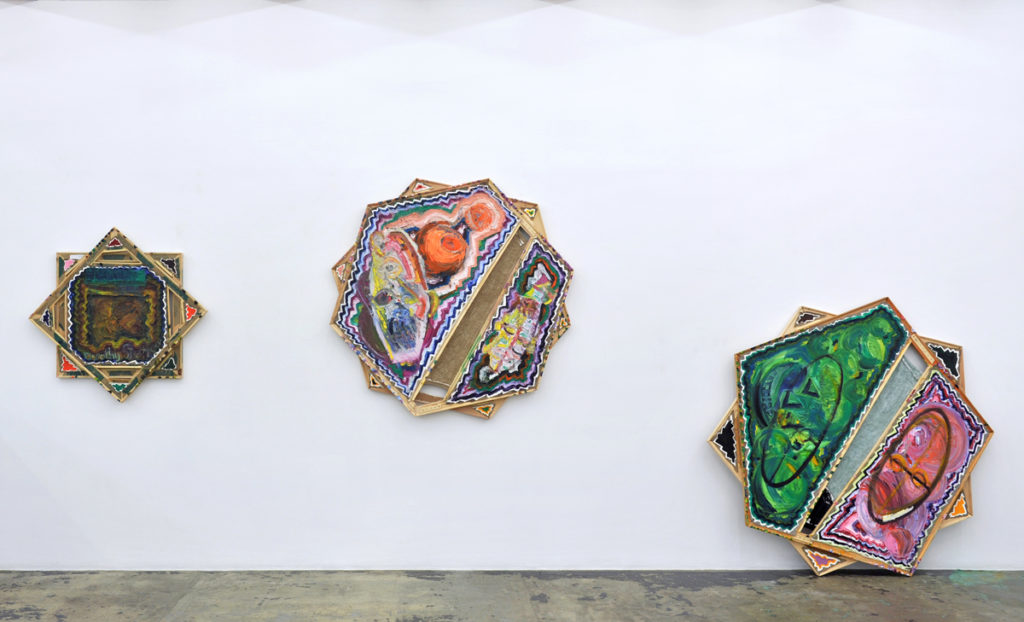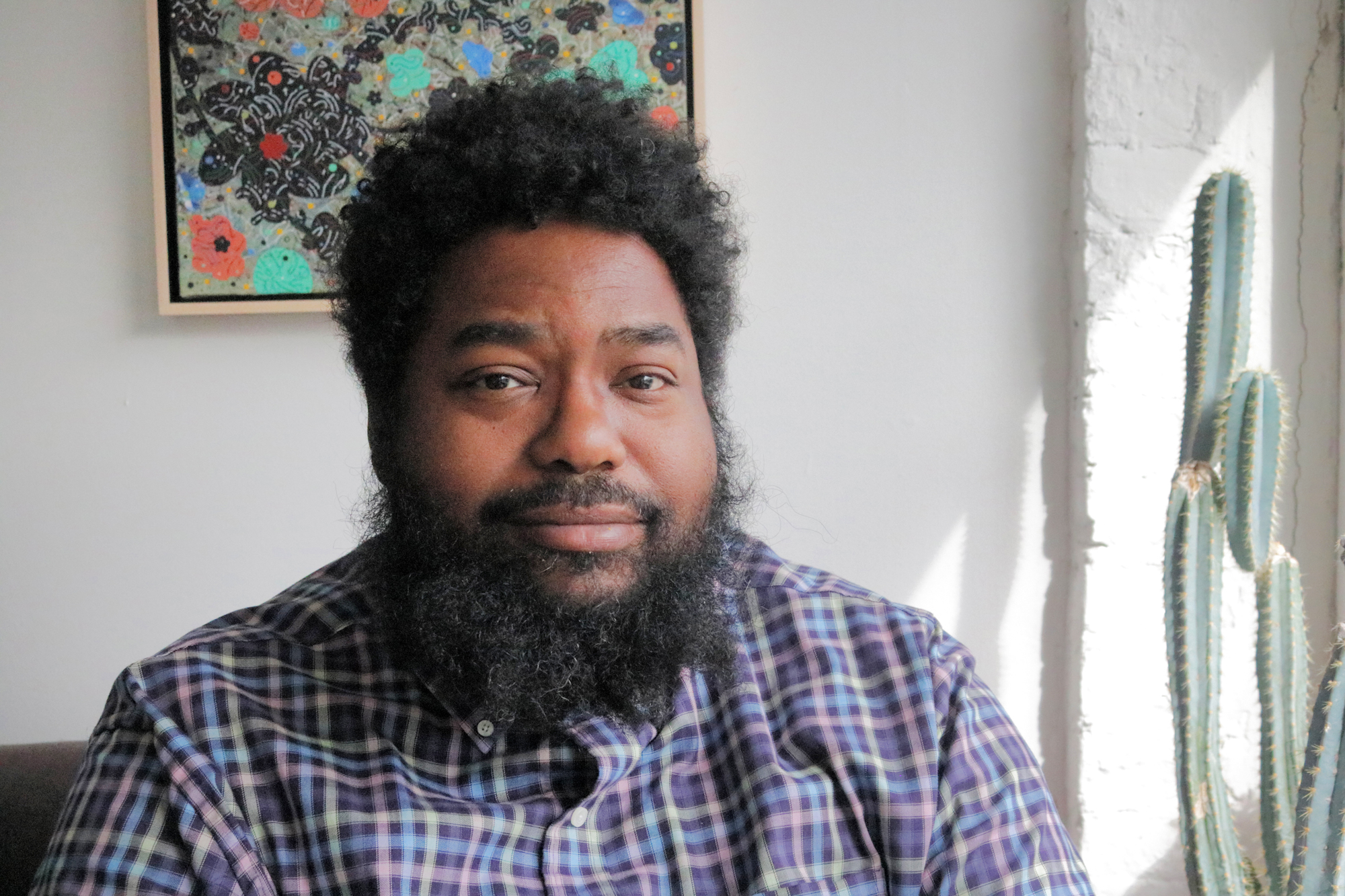[ad_1]

Mike Cloud.
COURTESY THE ARTIST
For over 15 years, in paintings, sculptures, and collages, Mike Cloud has conducted a sustained examination of how images are presented and received, both in the realm of art and in the larger world. Although the Chicago-based artist, now in his mid-40s, refers to himself as mostly an abstract painter, his work is profoundly political.
“What makes Mike different from many other black artists his age is that he is really resistant to putting images of black people in his paintings,” the writer and artist Christopher Stackhouse told me. “What is consistent in the work though, is that he’s constantly interrogating Western thought—its ideals, its history, its prerogatives.”
A consideration of the respective roles of viewer and subject—both within and beyond the context of art—is at the center of Cloud’s current solo exhibition at Thomas Erben gallery in New York (on view through November 9). Comprising two related series of canvases—the “Hanging Paintings,” devoted to people who have died by hanging, and the “Beheading Paintings,” about people who have been decapitated—the show asks what form a painted portrait might take.

Mike Cloud, Bennington 2017, 2019, oil on canvas with mixed media.
COURTESY THE ARTIST AND THOMAS ERBEN GALLERY, NEW YORK
In a recent talk at the gallery, Cloud told the audience that his impetus for making these new works was the controversy surrounding Dana Schutz’s 2016 painting Open Casket. Based on a photograph of the mutilated body of Emmett Till, the 14-year-old African-American boy who was lynched in Mississippi in 1955 for supposedly whistling at a white woman, the work—by a white artist—stirred an impassioned public response when it was shown in the 2017 Whitney Biennial. Visual artist and writer Hannah Black called for it to be removed from the exhibition and destroyed and artist/activist Parker Bright’s protested in front of the work wearing a shirt reading “Black Death Spectacle.”
Cloud pointed to Schutz’s stated motivations as part of his issue with the piece. “Someone asked her why she painted that painting of Emmett Till,” he said. “And her answer was Till’s mother and her love for her son. She explained that she has a child that she loves, and that allowed her to imagine the grief that Till’s mother felt. She then used that imagined mourning as the emotional impetus of the work. [Her] empathy (as distinct from sympathy) [did] not require that she feel love for Till but only that she be able to imagine that someone might feel such a thing.”
Cloud believes that was why Schutz’s painting made people so angry. “One of the things about black people in America is that our suffering is something one sees on TV,” he added. “It’s a mediated event. Hegel mentions the concept of reconciliation. When a painter paints a portrait, they must reconcile themselves to the subject of the portrait. I felt that if Schutz had proposed to actually make a painting of Emmett Till, proposed a reconciliation with him rather than a photograph of his suffering, that people would have been more open to it.”
He paused, and added, “So the question is, how do you paint people as real, as suffering, without exploiting them emotionally?”

Mike Cloud’s Cantanheade Portrait, 2019, oil on canvas.
COURTESY THE ARTIST AND THOMAS ERBEN GALLERY, NEW YORK
Since his debut solo exhibition in 2004 at Max Protetch Gallery in New York, Cloud has drawn from the culture at large to question aesthetic and social conventions and hierarchies. For a 2004 series of collages based on pictures taken by such women photographers as Diane Arbus, he cut up and reassembled some of their most iconic images into works less easily parsed. And in his shaped “Quilt” paintings from 2008, the artist sewed new children’s clothes—some with the tags still on—to canvases and then added painted words and images in a kind of call and response to the clothing’s mass-market vocabulary of rabbits, snowmen, and superheroes.
Words and symbols have likewise served as productive starting points. For his first show at Erben in 2014, for instance, Cloud produced Removed Individual, a 10-by-20-foot painting in the shape of a double Star of David with, at its center, a color chart offering a selection of blues paired with a list of grocery-shopping conundrums (“Green vs. Black Tea,” “Red vs. Green Cabbage”)—mundane choices that conjured the far less mundane judgments represented by the star, used by Nazis to identify Jewish prisoners.
“I was wondering how to make a very big painting that was not about how awesome a big painting is,” Cloud told me. “I was trying to get around modernism and the victory of abstraction. I was thinking that in color theory, colors are considered either weak or strong. And I was thinking about the politics and emotions tied up in Bauhaus and Cold War formalism, so I made this giant Star of David painting. And nobody experienced it as being triumphant.”
This pursuit of multiple lines of inquiry at once, and the blurring of painterly and conceptual concerns, can make Cloud’s work difficult to categorize—which may be the most political thing about it. “I think he is an important artist of my generation, especially in the way he addresses mythmaking, both in his painting, which is discursive in its own way, but also in his writing,” artist Leslie Hewitt told me. “He writes quite extensively, not always for publication, and he has a very strong voice and an understanding not only of art theory and art history, but of the frameworks from which they arise. At the same time, his ways of working with material and space challenge all my assumptions as a viewer, which may be why it’s hard for people to read his work—all those things are present in it all at once.”
Or, as the artist Peter Halley noted, “What I admire about Mike’s paintings is how they can be so conceptual, and at the same time so tactile. When I look at one of his canvases, I think of Barnett Newman’s works from the early ’40s. Like Newman, Mike is an intellectual provocateur.”

Installation view of “Mike Cloud: Tears in abstraction,” 2019, at Thomas Erben Gallery, New York.
COURTESY THE ARTIST AND THOMAS ERBEN GALLERY, NEW YORK
As is usual for Cloud, his new works—arrangements of exposed stretcher bars and paint-slathered canvas—are as much relief sculptures as paintings. “I’ve always felt that there was a really strong formal noise created by the format of painting,” Cloud told me as we walked through the exhibition. “If you have a big, rectangular, unbroken surface, no matter what you put on it, it’s always about a certain kind of order. Dealing with that formal noise and trying to harness it or subvert it is something I’ve always done.”
The “Beheading” series is conceived as a mathematical progression, beginning with a work in the shape of a six-pointed star and ending with painting made from two hexagrams, one laid over the other. The canvases are largely nonobjective, though several feature crudely drawn eyes, noses, and mouths. In some, pieces of terry toweling and strips of Whole Foods grocery bags add found color. A few bear the names of their subjects, as in the piece titled after Dorothy Stratten, a Playboy playmate murdered by her boyfriend.
The “Hanging” paintings are even more abstract. Each consists of two stretcher bars nailed together lengthwise, with the bottom bar snapped in half and hanging down to form a roughly triangular frame. From the pegs on the top stretcher bar dangle cheap belts made into nooses, while a URL scrawled in pencil links to the subject’s history and the story of their death. A few of these people—including fashion designer Kate Spade and celebrity chef Anthony Bourdain—are famous, but many are obscure. Most are suicides, though some are victims of murder made to look like suicide or even accidental autoerotic asphyxiation.
Cloud finds the names by scouring Wikipedia’s lists of people “who have died in extraordinary ways,” he explained. He makes sure to include subjects from different countries, as a way to avoid re-inscribing “a digital bias toward white males.” “In these paintings,” he said, “I’m trying to reconcile myself with the subjects of the portraits in a way that’s consistent with a religious love. When you look at the painting you can’t see the people. You can only see my reconciliation to those people. But if my reconciliation is of the right type, it can be communal.”
Whether or not a portrait consisting of a URL is any less exploitative than an image of a suffering body remains an open question. But open questions are Cloud’s stock in trade. “Mike has genuine faith in the prospect of communication through painting,” Stackhouse said. “He believes in it. And everything else is a kind of dismantling. It’s quintessential trickster stuff.”
[ad_2]
Source link

